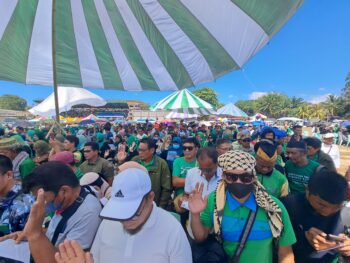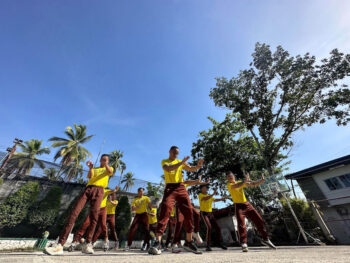DAVAO CITY (MindaNews/19 December)–With the release of “Power Sharing”, the 3rd annex of the Framework Agreement on the Bangsamoro, the situation of Indigenous Peoples (IP) in the Bangsamoro reached a critical point of clarification. Within Part 3, section 3 of the annex, are the list of exclusive powers of the proposed Bangsamoro government, including jurisdiction over: (21) Culture and Language; (24) …Historical, Cultural sites; (27) Customary Laws; (29) Ancestral Domain and Natural Resources; (30) Protection of the Rights of IPs… in accordance with the U.N. Declaration of the Rights of Indigenous Peoples; (31) Land management… distribution…and use reclassification; (39) Customary justice, to name the most prominent. Thus, the issues closest to the heart of the IPs fall squarely in the jurisdiction of the Bangsamoro government. Now, “here’s the rub” as they say….
The foundation for the assertion of right to self-determination (RSD) of IP communities is culture and ancestral territory – land. Since the creation of the ARMM, the office mandated within the autonomous region to facilitate the delivery of the ancestral domain claims of IPs (the largest being the Teduray, Aromanon and Lambangian tribes, along with other smaller groups) is the ARMM Office of Southern Cultural Communities (OSCC). However, there has been a tug of war within and outside the OSCC in implementing the mandate of IPRA, especially in terms of IPs obtaining their certificate of ancestral domain titles (CADT). The effect of this is that there was little to no progress in the titling of IP lands in the ARMM to date.
Consequently, the NCIP finally proposed a Memorandum of Agreement with the ARMM to push this agenda forward allowing the processing of CADTs within the territory. This would have been signed last September 2013 but the signing was aborted, ostensibly due to the Zamboanga siege. In the perspective of many IPs, they lost their last best chance to have the rights to their ancestral domains vested in the new Bangsamoro Territory, as land rights are guaranteed in the Framework Agreement on the Bangsamoro.
The IP leaders and their support groups that were pushing for CADTs under IPRA assert that IPRA, which the Supreme Court has indicated was meant “to correct historical injustice” stands as a Philippine government – First Nation peace agreement on par with other peace accords such as the 1996 Final Peace Agreement with the MNLF.
Significantly, this “treaty” protecting the IP right to self-determination (RSD) was obtained primarily through non-violent means. The only thing needed, in this perspective, is simply to fully implement its provisions within the ARMM – and the proposed Bangsamoro – as it is recognized globally by IP advocates as one of the best legal instruments protecting IP RSD in the world.
On the other side, the MILF has asserted that the “hold in abeyance” strategy on IP CADTs in the Bangsamoro is actually in the best interest of the IPs, with reassurance that an “IPRA-like” law will be instituted in the Bangsamoro. The MILF states that it would be impossible for them not to consider the best interest of the IPs since of the three founding members of the MILF, one was a pure blooded Teduray. They promise that the result of the GPH-MILF process will deliver a “better deal” than IPs currently receive under IPRA. The operative symbol of this approach is the plea of MILF to IP leaders to “catch the chicken together first, and then we will divide it amongst ourselves.” The IPs holding to this line, along with their support groups, see the reaffirmation of Bangsamoro and IP kinship as foundational to the formulation of a sharing agreement between the MILF and IP communities in Mindanao at some point in the future.
In light of the new Power Sharing annex, significant questions arise for the IP leaders of communities who will be included in the Bangsamoro, as well as for those outside, especially in border areas that could petition for inclusion in the new territory. There is now an additional layer in the complex, brotherly and sometimes antagonistic history of IP-Bangsamoro relationships. Can the mistrust that occurred as an (unintended?) consequence to the “hold in abeyance” strategy on CADT processing be restored? Will the primary parties and NGOs create a genuine space in the peace process where IP leaders across the spectrum can dialogue and input on these issues?
The inclusion of IP representatives in the peace panels and transition commission have helped build confidence in the process, but they are not enough. Can the different IP support groups supporting these representatives, along with their diverse perspectives, take the time to reflect and find a way forward that respects the deepest and widest cultural needs and aspirations of Indigenous Cultural Communities in the Bangsamoro? How these questions are answered will determine whether the dearly held aspects of Ancestral Domain and Indigenous Culture become sources of peace, or sources of mistrust, in the on-going process of reconciliation in Mindanao.
Part 2: Cultural Confidence Building – Restoring Trust in the Bangsamoro
(Jeremy Simons is an instructor at the Mindanao Peacebuilding Institute and Peacebuilding Organizer and Restorative Justice Consultant living in Davao City. You may reach him through justpeaceadvocate@gmail.com)







